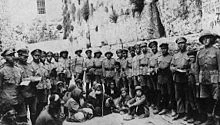| Line 5: | Line 5: | ||
==The Fall of Jerusalem== |
==The Fall of Jerusalem== |
||
| − | Falkenhayn immediately launched a series of attacks against Allenby's lines. (The [[Ottoman Empire|Turks]] had fortified various places in a ring around [[Jerusalem]], including the hilltop of Deir Yassin.) Allenby regrouped his forces and sent the XX Corps, under Philip Chetwode to capture the city. Chetwode's attack on 8 December took the heights to the west of Jerusalem and a second attack captured positions south of [[Bethlehem]]. The Turkish counter attacks had failed and Jerusalem fell to the British the next day. |
+ | Falkenhayn immediately launched a series of attacks against Allenby's lines. (The [[Ottoman Empire|Turks]] had fortified various places in a ring around [[Jerusalem]], including the hilltop of Deir Yassin.) Allenby regrouped his forces and sent the XX Corps, under Philip Chetwode to capture the city. Chetwode's attack on 8 December took the heights to the [[File:300px-Allenby_enters_Jerusalem_1917.jpg|thumb|General Allenby enters Jerusalem on foot, 11 December 1917]]west of Jerusalem and a second attack captured positions south of [[Bethlehem]]. The Turkish counter attacks had failed and Jerusalem fell to the British the next day. |
==Allenby's entry== |
==Allenby's entry== |
||
Revision as of 21:16, 5 March 2013
The Battle of Jerusalem resulted in the city of Jerusalem falling to British Empire forces in December 1917. On 11 December, Edmund Allenby entered the city on foot out of respect for the Holy City, becoming the first Christian to control the city in centuries.
Background
The Egyptian Expeditionary Force, under the newly appointed Commander-in-Chief General Edmund Allenby, had won the decisive Third Battle of Gaza in early November. Allenby's forces followed up the retreating Turks and defeated them again the Battle of Mughar Ridge in the middle of November. His forces now moved on Jerusalem. Allenby's left flank was secured at Jaffa and his right flank was moving through the Hills of Judea. The German General Erich von Falkenhayn, commander of the Turkish forces in Palestine, had recently received reinforcements and was quickly planning to launch a counter offensive against Allenby. Both sides had been instructed to avoid fighting in or near the Holy City.
The Fall of Jerusalem
Falkenhayn immediately launched a series of attacks against Allenby's lines. (The Turks had fortified various places in a ring around Jerusalem, including the hilltop of Deir Yassin.) Allenby regrouped his forces and sent the XX Corps, under Philip Chetwode to capture the city. Chetwode's attack on 8 December took the heights to the

General Allenby enters Jerusalem on foot, 11 December 1917
west of Jerusalem and a second attack captured positions south of Bethlehem. The Turkish counter attacks had failed and Jerusalem fell to the British the next day.
Allenby's entry
Allenby was an accomplished horseman and it would have made sense for him to ride triumphantly into the city. However on 11 December Allenby entered on foot out of respect for the Holy City.
Allenby placed the city under martial law, and posted guards at several points within the city and in Bethlehem to protect sites held sacred by the Christian, Muslim and Jewish religions.
In the United Kingdom, the capture of the city was seen as a fulfillment of the medieval crusades. Punch magazine published a cartoon of the English Richard the Lionheart, the crusader king of England, saying "At last my dream come true."
Turkish counter attack
The fall of the city and the failure of Falkenhayn's initial attacks greatly lowered the Turkish morale. Sporadic fighting continued in the hills surrounding Jerusalem. The Turkish forces were being reinforced by the Yıldırım Army Group, which originally had been formed to recover Baghdad from British forces in Mesopotamia. These forces had arrived on the field piecemeal but by now they were fully on the field. On Christmas Day, Falkenhayn launched another counter assault, which was repulsed with heavy losses.
Results
The Battle of Jerusalem was a welcome victory for the Allied forces. Allied forces were faced with stalemate on the Western Front at Cambrai, the Italians were defeated at the Battle of Caporetto and Russia was effec

Jewish Legion soldiers at the Western Wall after British conquest of Jerusalem, 1917
tively out of the war following the Bolshevik Revolution. The fall of Jerusalem offered the Allied nations much relief from these setbacks. Campaigns in Mesopotamia were cancelled to send reinforcements to Allenby. The Turks lost control over central Palestine and the following year were completely driven from the region after the Battle of Megiddo.
The battle honour Battle of Jerusalem is still carried by British units such as the Queen's Lancashire Regiment
References
- First World War.com: The Fall of Jerusalem, 1917
- Tucker, Spencer, The Great War: 1914-18 (1998)
- Grainger, John D, The Battle for Palestine, 1917 (Woodbridge: Boydell Press, 2006)
| This page uses content from the English Wikipedia. The original article was at Battle of Jerusalem (1917). The list of authors can be seen in the page history. |